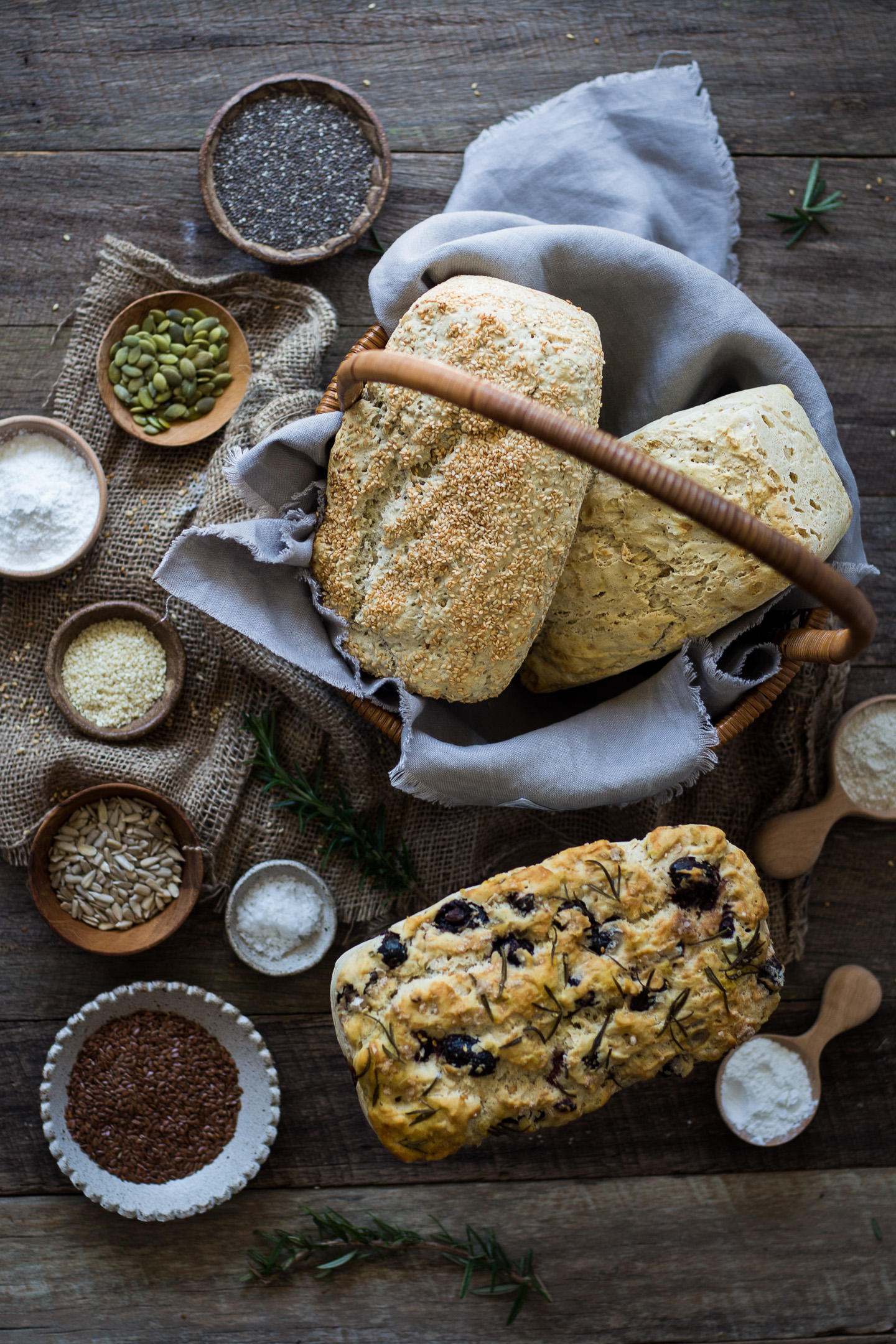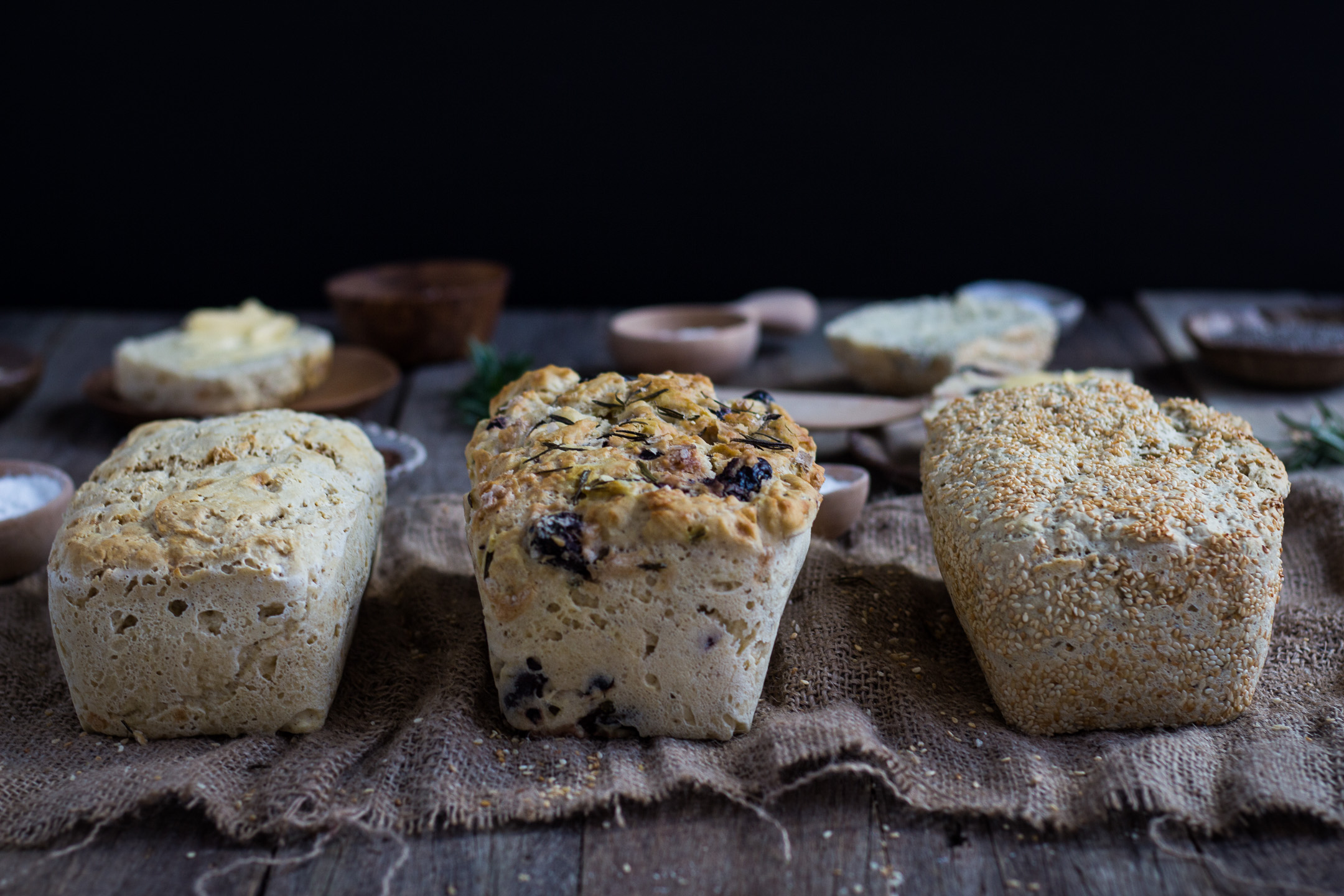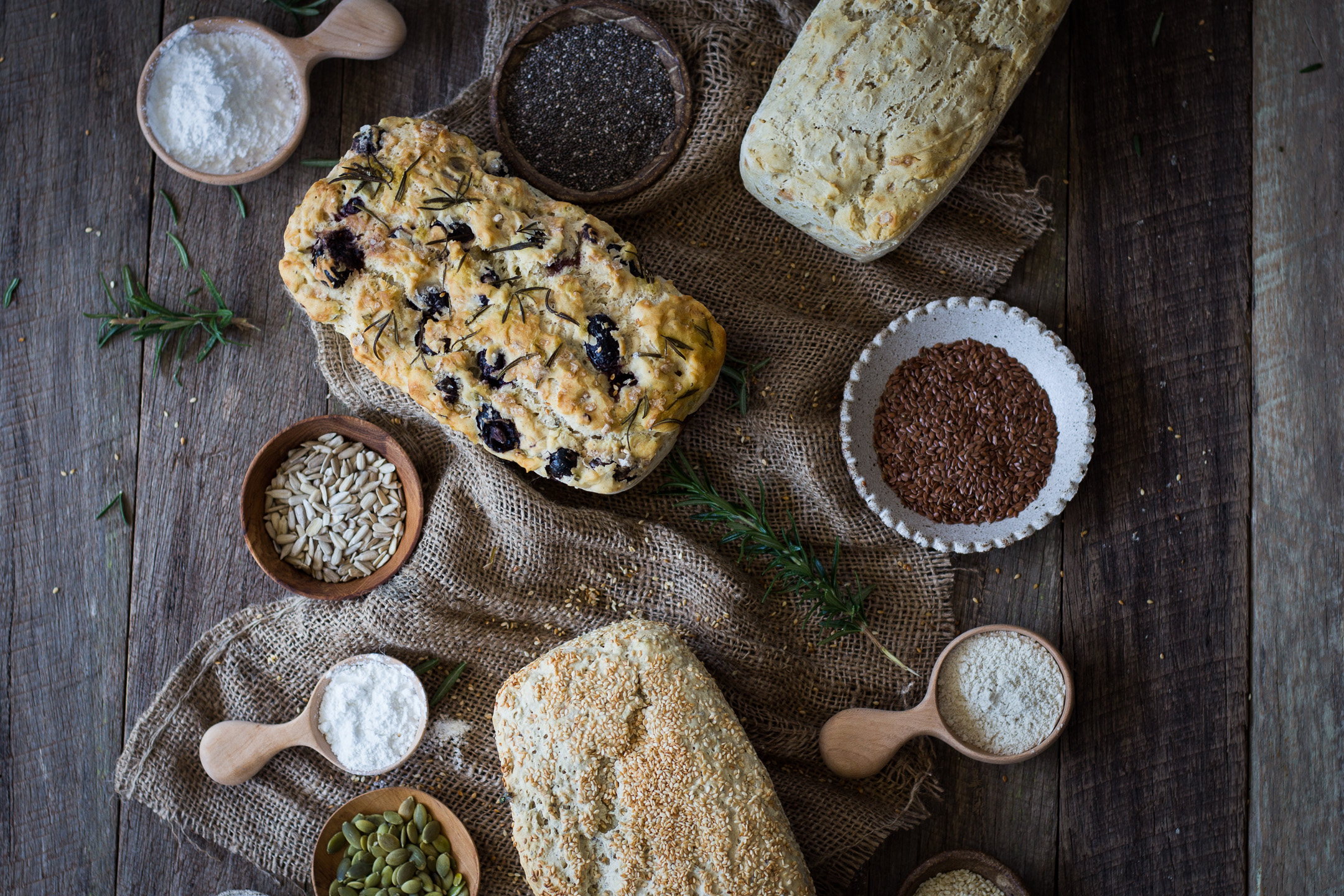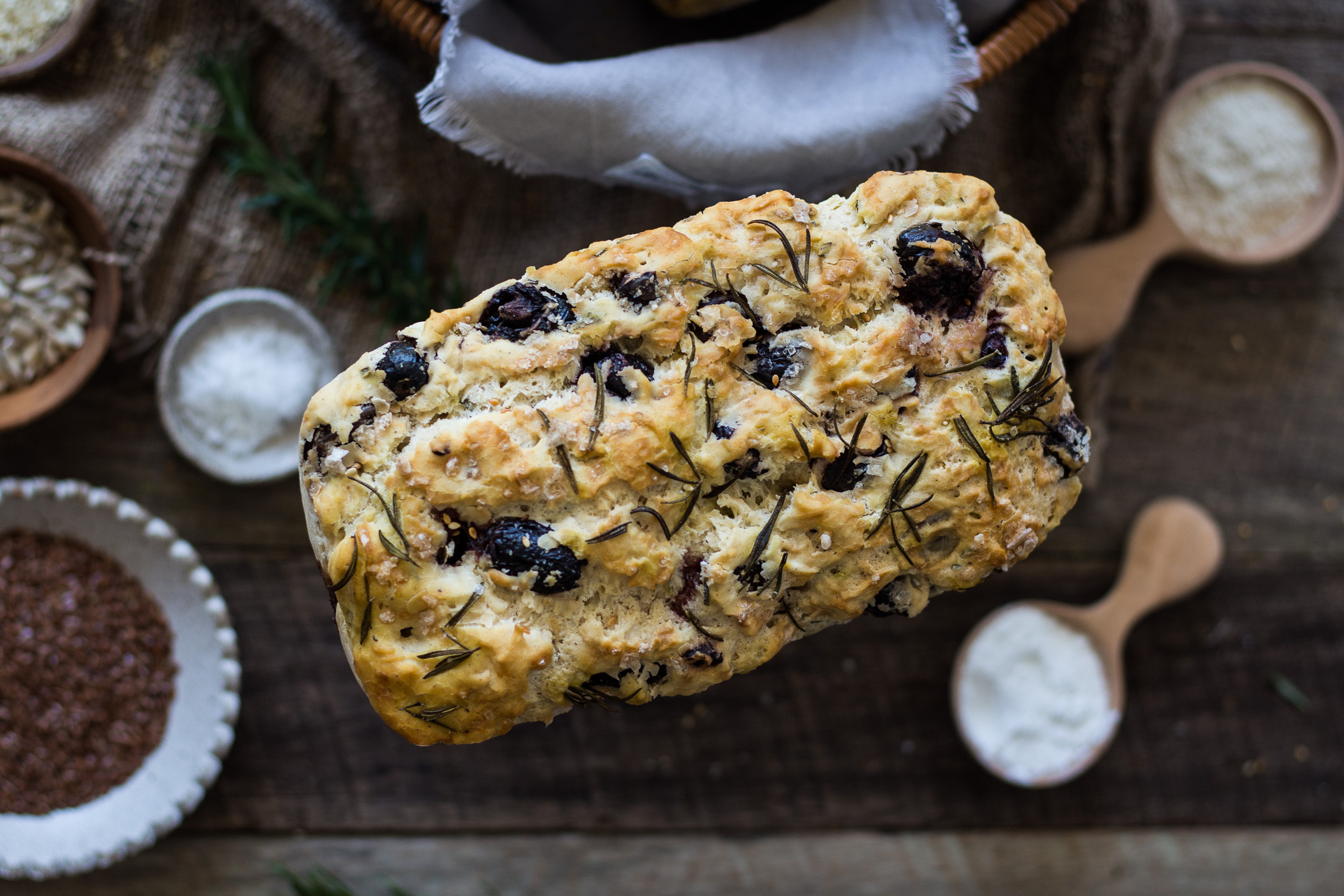

Ask anyone what they miss most when they switch to a gluten free diet and I can guarantee they will answer ‘bread’. Not just any bread. Soft, light, moist bread that bends, does not disintegrate and does everything normal bread does.
After countless requests for a delicious gluten free bread recipe I decided to go back to basics this week and bake Perfect Gluten Free Bread 3 Ways – White, 5 Seed and Rosemary & Olive. I consumed copious amounts of bread during the ‘production phase’ (hello stretchy pants) and tested every gluten free flour combination possibly imaginable. The good news is your search for the perfect gluten free bread recipe is finally over! This bread is super soft, moist, springy, bouncy and absolutely delicious. Even those without a gluten allergy will devour it once it hits the kitchen bench.


My personal favourite is the Rosemary & Olive version because I have a slight olive obsession. A drizzle of olive oil and sprinkling of sea salt flakes on the dough prior to baking results in the most beautiful golden crust, so ensure you don’t skip this step.
The White version will appeal to the whole family and 5 Seeds is great for those who prefer texture, crunch and added goodness in their loaf.
Gluten free baking is a science so take care to use exact measurements otherwise the final result will be impacted. I level out my flour in the measuring cup with a knife to ensure my measurements are exact, not estimates.

Now, a lesson on gluten free flour blends.
To create a well balanced gluten free flour blend it is ideal to combine wholegrain flour (such as buckwheat, sorghum, brown rice, teff, millet and quinoa) for protein and fibre with starch flour (such as sweet rice, potato, tapioca and corn) to provide bulk and hold the mix together. The ratio of each blend can be varied depending on what you are trying to achieve and how mild or earthy you want the final flavour to be. You can substitute flours in each category if you suffer from additional allergies. For example, if you suffer from a rice allergy you could substitute rice flour for tapioca. Be careful as you will need to adjust your quantities slightly because different flours have different weights and absorb water differently. At this point I would advise that you look for the correct texture when mixing. The dough should look like a thick, stretchy cake batter.
Here is a breakdown of each specialty flour and the role it plays in this bread mix.
Potato Starch is made from the dried starch component of peeled potatoes. It is great for adding moisture to dough and delivers a light, fluffy texture. Potato Starch can be found in health food and specialty stores and Asian grocers.
Tapioca is a flour made from the cassava plant native to South America. I love tapioca because it has a slightly sweet flavour and great binding properties that deliver a springy texture to baked gluten free goods. Tapioca is readily available in the supermarket baking or health food aisle.
Sweet rice flour (also known as glutinous rice flour) is ground from high starch short grain “sticky rice”. It is an excellent ingredient for baking gluten free breads and cakes because it adds moisture and has exceptional binding qualities. It is not the same as regular rice flour ground from long grain or medium rice so do not confuse the two flours. Sweet rice flour is much higher in starch and this is desirable in gluten free baking.
Sorghum flour is ground from the ancient grain sorghum. It is a nutrition powerhouse high in protein, fibre and iron. Sorghum has a smooth texture and mild sweet taste adding delicious flavour to gluten free baked goods.
Xantham Gum is a great binding and thickening agent in gluten free baking. It helps trap the air bubbles created by leavening agents such as yeast to allow your bread to rise. It is derived from the outer layer of the Xanthomonas Campestris bacteria.
Apple Cider Vinegar helps give the yeast mixture a boost to create a beautiful rise when baking.
- 300mL lukewarm water
- 1 tsp sugar
- 1 x 7g yeast sachet
- 1 cup or 120g tapioca flour
- 1 cup or 120g sweet rice flour (also known as glutinous rice flour)
- ¾ cup or 120g potato starch
- ½ cup or 70g sorghum flour
- 2 tsp sea salt flakes
- ½ tsp xantham gum
- 2 eggs lightly whisked, room temperature
- 3 tbs olive oil
- 1 tsp apple cider vinegar
- Add sugar and yeast to lukewarm water. Whisk together and let it stand for 15 minutes until mixture foams.
- Sift flours, salt and xantham gum together in a mixing bowl or place in a Thermomix and blend speed 5/3 sec.
- Add eggs, olive oil, vinegar and yeast mixture and beat to combine in mixing bowl or in Thermomix speed 4/15 sec scraping sides down halfway.
- Spoon mixture into a 20 x 10cm loaf tin and cover with cling wrap. Allow bread to rise in a warm place for 1 hr until it doubles in size.
- Preheat oven to 200C. When oven is ready, drizzle olive oil on dough to create a golden crust when baked.
- Bake for 50-55 minutes or until golden and a skewer comes out dry.
- Remove from oven and immediately transfer to a wire rack to cool. This helps your crust stay crispy. Cool for at least 2 hrs before slicing.
- Add 1 tbs of each of the following seeds to dough mixture and mix to combine - pepita seeds, sunflower seeds, sesame seeds, linseeds and chia seeds. Sprinkle sesame seeds on base and sides of tin prior to spooning dough in tin to create a seeded crust.
- Add 2 cups of pitted kalamata olives and 2 tbs of chopped rosemary to dough mixture and mix to combine. Prior to baking sprinkle rosemary and sea salt flakes on loaf and drizzle with olive oil.This loaf requires an extra 5 min baking time due to extra moisture and volume from the olives.

Holy cow Helen! I thought my bread was pretty good but I made your bread recipe today and it beats mine hands down! The kids went crazy, ate the whole loaf and are pleading for more. Thanks heaps for this recipe, its an absolute winner. GF bread is notoriously tricky but your recipe was easy and incredibly good. Your blog is ruining my waistline! (not that I’m complaining.)
Karen.
Karen I’m glad they loved it. I am the only one who is gluten intolerant in my family but my husband and kids scoff it down too, they have no idea it is gluten free. Try the olive version next, that one is my favourite and sorry about ruining your waistline. Ha!!!
Can i replace sweet rice flour with something else in this recipe?
Thanks
Yes you can use regular white flour, brown rice flour or buckwheat flour.
Thank you Helen! I have made this bread four times now and it’s perfect every time. (And now I’ve got your rough puff pastry chilling in the fridge… Really excited to try that too!) Is it possible to pre- mix the dry ingredients and store them so as to save a little time? Or would they not keep once mixed together? I’m brainstorming ways to make regular bread making quicker with small kids in tow 🙂
Katherine I’m so happy to hear you love the gluten free bread as much as I do. Once you experiment with gluten free flours you soon learn the baking properties of each.
You can premix the flour just store it in an airtight container away from sunlight.Happy baking!
Thanks Helen. I made the rough puff pastry and it was delicious, so thanks for that recipe too. Onwards and upwards in the land of GF!
Hi just wondering what your premix flour blend is that I can store in the pantry, I use pre package flours and keen to have my own healthier blend on hand for all my baking
Hi Sam
I don’t have a gluten free premix I just blend different flours depending on what I want to make.
If I am using a packaged pre-mix for a cake I use Bob’s Red Mill 1 to 1 plain gluten free baking flour (blue label). I find it is the best quality gf blend on the market, you can find it online or at health food stores. Thanks. Helen.
Hi Helen, this is probably the best bread recipe I’ve tried since beginning to tinker in gluten free baking – there have been some real stinkers, but this one is really tasty with a nice texture as a bonus. How would you suggest I store any leftovers?
Emma I’m so glad you loved it. I would suggest storing unused bread in an airtight container. After the second day you can slice the bread and store it in the freezer for a month. Just pull out slices as you want them and toast for breakfast.
I just made this bread (just a plain one) and it is amazing. It’s the best tasting and looking gluten free bread I’ve made so far and I’ve tried a few. A lovely soft and spongy texture and it tastes like the real deal. I’ll have to get your cook book. Keep up the good work!
Thank you so much for your lovely feedback Marianne. I really struggled to find soft bouncy gluten free bread when I cut gluten from my diet and tried every combination out there before I settled on this one. In my new gluten free cookbook I also have a fantastic High Fibre Buckwheat and Chia Loaf which is really easy to make, soft, seeded crust and high in fibre. It’s my current ‘go to’ for breakfast. Enjoy!
Hi Helen, wondering if anyone has tried this with an alternative to yeast and has it been as successful? Thank you!
Hi Rita
I have only ever made it with yeast but you could try 1 tablespoon baking powder as a substitute. Like I said I have never made it myself so it will be a case of trial and error. Let me know how you go.
Well as a passionate amateur cook and lover of homemade artisan sourdough bread with a trending gluten intolerance, I was amazed and delighted by this incredible recipe and now I have tried it (already had the ingredients in the fridge) I doubt I will cook another for a very long time. Thanks so much for saving us from ‘cake’ bread. Can’t wait to explore your other sophisticated recipes. Thank You Helen X
Fiona I’m so glad you liked it. Such an amazing feeling when you can finally eat soft bouncy bread again isn’t it? I also have a great High Fibre Buckwheat and Chia Loaf in my new cookbook. It’s my current breakfast staple. Have a lovely Xmas.
I’ve made this twice in a week now. I altered it slightly as I can’t tolerate Sorghum so replaced that with white rice flour and had prepared myself for disappointment as I know its not easy to substitute in Gluten free baking but it turned out amazing! Like a cross between a white loaf and Turkish bread. So fluffy and bouncy and just yum. Will definitely try it with seeds next time to boost the nutritional content a bit.
Hi Kase
So glad you loved it. If you can tolerate millet flour this is also a good substitute for sorghum and has similar nutritional properties. Have a lovey Xmas and fantastic 2018. Helen.xxx
Do you think it would be OK to substitute arrowroot for tapioca? I know they are usually interchangeable but don’t want to waste ingredients.
Yes it should be fine.
Hi Helen
I made this bread couple of times and each time it came out wonderful and my family really enjoyed. Today I am running short of Potato starch. Can I sub this with with any thing else.
Hi Bini,
You could replace the potato starch weight with a combination of tapioca and sweet rice flour. Just split the weight equally. Tx.
Helen.
I just made this onto rolls by scooping out blobs onto a floured and oiled baking sheet and cooked for 20 minutes. They could have had perhaps another 5 minutes, but they were lovely and springy on the inside and a shell on the outside. We have been without bread now for 6 weeks so this was a nice treat!
Glad to hear your gluten free bread rolls were delicious Sue. After 6 weeks they must have been thoroughly enjoyed!
Take care, HT.xx
Hi, love your bread recipe, so thankful I found your recipes….have you ever substituted sourdough starter for the yeast? One recipe suggested replacing 50grams of flour with starter. Have you ever or do you have a gf sourdough recipe?
Hi Jaine
I have not made it with a starter but I do not see why it wouldn’t work. Please let me know how it turns out. Good luck!
Hey, Helen! Thank you so much for creating, and sharing your recipes. I have only just discovered your fabulousness ❤👍So; I made this bread — the plain version — for my daughter, the other day. She’s sharing her breast milk with babies who can’t tolerate gluten, soy, or dairy. The bread was amazing! She said it was the best GF bread she’d had. I was wondering if you have any suggestions on how to make it a muesli-type/raisin loaf, please? I have some ideas, but it could possibly turn into a ‘Nailed it!’ meme. Once again, a huge thank you for sharing this amazing recipe.
Hi Kelly,
Thank you so much for your beautiful message, I’m so glad you loved my gluten free bread recipe. If you want to convert it to a fruit loaf I would suggest adding 1 cup of raisins, 1 tsp of cinnamon and 1 tsp of all spice. Let me know how it turns out! Helen.xx
Hi there, I love this recipe. Do you have any tips on how to make this vegan? My girlfriend is GF and vegan! Bit of a challenge but I’m enjoying it. Love your blog and recipes by the way. From one passionate Greek foodie to another 🙂
Hi Nina
Glad you love my gluten free bread recipe. To make it vegan you just need to replace the eggs. Replace each egg with a seed mixture – for each egg mix 1 tablespoon ground flaxseed or chia seed with 3 tablespoons water. Refrigerate for 15 minutes so it goes sticky and mimics an egg texture. This is a good egg substitute.
Hi.. this recipe sounds delicious and I am really wanting to try this out as I am craving yummy bread since I have been diagnosed with Celiac disease. I am having problems finding the sweet rice flour and potato starch? Any substitutes that I could use that you would recommend?
H Maria
Sweet rice flour is also called Glutinous Rice Flour. You can find it in Asian grocers or in the Asian aisle of the supermarket, it is sold in thin plastic bags. You could substitute regular rice flour if you are struggling. Potato starch is harder to substitute but if you can’t find it for the this recipe just replace it with the same weight of tapioca.
I have just made the 5 seed bread, it worked out perfectly, what an amazing taste, probably too good as there is nothing better than a loaf of homemade bread. This will definitely be a recipe that I share with others and make on a regular basis.
Thanks Sandra glad you loved my gluten free bread recipe.
Hi Helen
I am wondering if you have any thoughts on making your white bread in a bread maker? My little coeliac is starting school in a couple of weeks and I’m contemplating buying a bread maker to make five days of sandwiches a bit easier (and tastier than store bought GF bread!)
Thanks very much – your blog is fantastic for GF families!
Hi Megan
I have never used a bread maker so I could not comment on it. My gluten free bread recipes work like a cake batter so you only need a mixer or bowl and spoon. They are very easy to follow. Thanks.
Hi Helen, although my family are not Celiac, my brother and his 2 kids are. I’ve made your olive and rosemary bread quite a number of times now, although delicious, I have found that the kalamata olives very salty. My brother’s family also like it, but thought the same about the saltiness. I’ve reduced the amount I add however, they still overpower the taste due to their saltiness. I’ve even thought that next time I may soak the olives in some water first and see how that goes. Any suggestions? I’m going to try and make your seeded bread this weekend, Can’t wait.
Hi Rosanna,
I would not recommend soaking the olives in water this will make your bread soggy. Just reduce the quantity of olives by half and you will see a significant difference. Enjoy the seeded loaf! Cheers, HT.
Hi Helen,
Love, love, love the seeded bread. A huge success with family and friends 😃 Your recipes are so easy that it’s a delight to cook. Thank you.
Thanks Rosanna. Glad you love my gluten free bread recipe, the seeded is one of my favourite! Cheers, HT.
Hi Helen,
Could you tell me what is the best way to rise the dough in winter? Can it be put in a slightly warm oven to rise? My oven goes down to 30 degrees. Or where is the best place to put the dough to rise.
Thank you, just making my first batch now.
Hi Maggie,
Yes you can place your bread in the oven to rise but I would pre-heat the oven for a few minutes, switch it off and then let the bread rise in the slightly warm oven whilst it is off.
My bread tasted dry especially the crust and left a dry taste in my mouth. I measured all ingredients exactly. Can you suggest anything or a different type flour to remedy this?
Thank you,
Hands down AMAZING. I’m so impressed! It came together really simply, definitely resembled cake like batter (thank you for your detailed notes Helen!), and baked beautifully! I can’t wait to experiment further with other toppings. THANK YOU!
Great Susan glad you loved the gluten free bread recipe.
Hi Helen,
Which flour, and what amount would you swap for rice flour for someone who can’t tolerate it?
Thanks
You can replace rice flour with tapioca flour. Just use the same weight.
Could I swap the eggs for a psyllium husk gel? If so, what ratio do you suggest? Is rice flour okay to use in this or does it need to be glutinous rice flour?
Yes I would just use 1 tbs psyllium husk mixed with 3 tbs water as a replacement. Yes you can swap flour too. Texture will be slightly different but it still works.
Last question. Is xanthum gum necessary and if so, why can I replace it with?
Xantham gum acts as a binding agent. You can try replacing it will a psyllium gel. Mix 1 tbs psyllium husk with 3 tbs water.
Could you please tell me, what can I use instead of sorghum flour? as I am allergic to it.
you can use buckwheat or millet flour
I’m also allergic to buckwheat, I’m not sure about millet as I don’t think I’ve ever used it, but if it’s in the same family as sorghum and buckwheat, I more than likely am. Is there anything else I can use?
I would just replace with an equal amount of the other flours if that is the case.